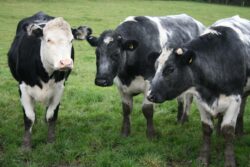Europe faces foot and mouth outbreak as Estonia and Czech Republic scramble to implement measures against foot-and-mouth disease as concerns for a major European breakout grow as at least four countries within the EU are on the watchlist.
So far Estonia, the Czech Republic, Slovakia and Hungary have all seen cases of the foot and mouth disease in livestock within their borders. Additionally Austria and Latvia are on the verge of confirming positive cases, which they believe have spread from Estonia.
Europe faces foot and mouth outbreak
In response to the potential outbreak of foot and mouth disease, both countries with positive cases, Estonia and the Czech Republic have enforced measures which they call stringent to prevent the spread of the virus, but backtracking and tracing the stock that has already left could be more complicated.
Slovakia is also considering tightening regulations around livestock, which has traced its outbreaks to Hungary, remains significant.
In Estonia several large farms have taken proactive steps to protect against the disease’s introduction. Andri-Peedo, located right on the Estonian-Latvian border and Nopri farm, has posted clear signs barring any visits to the premises.
These actions include restrictions on livestock movement and increased surveillance to safeguard agricultural sectors.
Meanwhile in the Czech Republic, the government has imposed strict controls at the border with Slovakia, where six outbreaks of the disease in livestock have been reported.
These border controls, while necessary, have resulted in disruptions, particularly for transporters, as they work to ensure that the disease does not cross into the Czech Republic from Slovakia.
How has the EU reacted to the foot and mouth outbreak?
Outbreaks of the disease in livestock, which primarily affects cattle and other livestock, have been reported in Hungary and Slovakia.
Austria has closed off two dozen border crossings with its neighbours, Hungary and Slovakia, in a bid to contain the spread of foot-and-mouth disease and prevent it from entering the country.
Slovakia declared an emergency situation on Tuesday after the disease was found on three farms.
On Wednesday, Hungary had its first outbreak of the highly infectious disease in 50 years, leading the country to deploy soldiers and launch disinfection measures to contain it in an area bordering Slovakia and Austria.
If any contact or signs of foot and mouth are spotted, you should immediately contact the European Commission for the Control of Foot-and-Mouth Disease.
Which animals are affected by foot and mouth (FMD) disease?
Foot and mouth disease (FMD) affects cloven-hoofed animals including:
cattle
sheep
pigs
goats
camelids
deer
It does not affect humans but spreads quickly amongst animals.
How foot and mouth disease is spread?
Foot and mouth disease is highly infectious.
Animals can catch the virus through direct contact with an infected animal.
The disease can also pass indirectly through:
equipment
vehicles
people
clothes
mud
bedding
any other item that has been in contact with infected animals.





